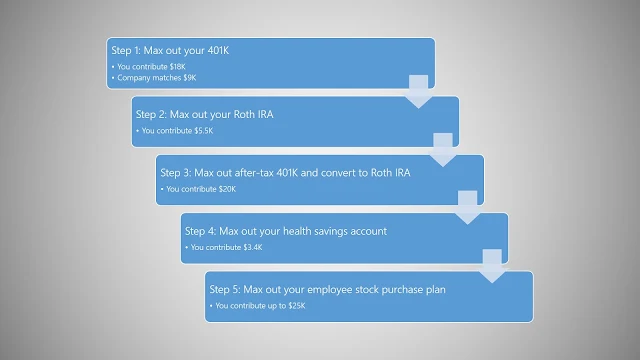 |
| Find out how to invest $81K a year, with much of it sheltered from taxes |
Every year when I file my taxes, I’m reminded about how much
of my income goes towards running the government. A little over 25% of my total
income goes towards income taxes, social security taxes, Medicare, and other
programs.
Over time, I’ve picked up several strategies that have
allowed me to amass a large net worth while either paying no taxes on my gains
or only paying taxes when I finally withdraw my investments.
Looking back, I wish someone had told me about all of these
strategies when I first started working so I could have implemented them earlier.
I wanted to share these 5 steps that
I’ve learned so you too can take advantage of these strategies. If there are
any others that you know, please share them in the comments.
As a note, I wrote this short guide for people who work for
companies and have access to programs like a 401K. Even if you don’t work for a
company, this content can still be relevant. For instance, if you work for the
government, you’ll have access to a Thrift Savings Plan, which is equivalent to
a 401K. Additionally, this article is for people who live and work in the
United States.
Step 1: Max out your 401K
As a first step, you should absolutely max out your 401K.
You can contribute up to $18K/year and you should contribute the full amount.
The company I work for is quite generous and they match 50% of your
contributions and vesting is immediate. This serves as an incentive to max out my
contribution. The earlier I max out in the year, the sooner I have access to
the $9K matching. I contribute all of the money pre-tax, so I only pay taxes
when I eventually withdraw the money.
- Amount invested: $27K (includes $9K matching)
- Total invested: $27K
Step 2: Max out your Roth IRA
If you make less than $116K, you can contribute $5.5K directly
into a Roth IRA. You pay taxes up front and you never have to pay taxes again
on any of the growth. If you make more than $116K, you can contribute $5.5K to
a traditional IRA and then convert it into a Roth IRA. It’s a backdoor way to
skirt around the income restrictions allowing you to still contribute the full
amount to your Roth IRA.
- Amount invested: $5.5K
- Total invested: $27K + $5.5K = $32.5K
Step 3: Max out your after-tax 401K and convert to a Roth-IRA
Once you’ve maxed out your Roth IRA, contribute $20K to your
401K after-tax. Once you max this out, roll it over to your Roth IRA. This
allows you to funnel another $20K into a Roth IRA. Once in a Roth IRA, you
never have to pay taxes on any of the gains.
- Amount invested: $20K
- Total invested: $27K + $5.5K + $20K = $52.5K
Step 4: Max out your health savings account (HSA)
Once you max out your after-tax 401K contributions,
contribute $3.4K to your health savings account. This is untaxed money that you
can use towards healthcare expenses. Once you’re in your 60s, you can use this
for healthcare, or anything else. If you decide to use the money for
non-healthcare expenses, it’s just like a traditional IRA where you pay taxes
on it when you withdraw.
- Amount invested: $3.4K
- Total invested: $27K + $5.5K + $20K + $3.4K = $55.9K
Step 5: Max out your employee stock purchase plan (ESPP)
Many companies offer employees a stock purchase plan. This
allows you to save another $25K or 15% of your income, and depending on the
company, you’ll get an instant discount on company stock. My company offers a
10% discount on stock. I typically sell the company stock immediately after the
offering period and invest it elsewhere. You can read this article
on the merits of investing in an ESPP. Although an ESPP is not protected from
taxes, the discount on stock is an immediate return.
- Amount invested: $25K
- Total invested: $27K + $5.5K + $20K + $3.4K + $25K = $80.9K
You’re all set
If you take advantage of all of these strategies, your net
worth will skyrocket in no time. Now that you know what accounts to put your
money into, where should you invest it?